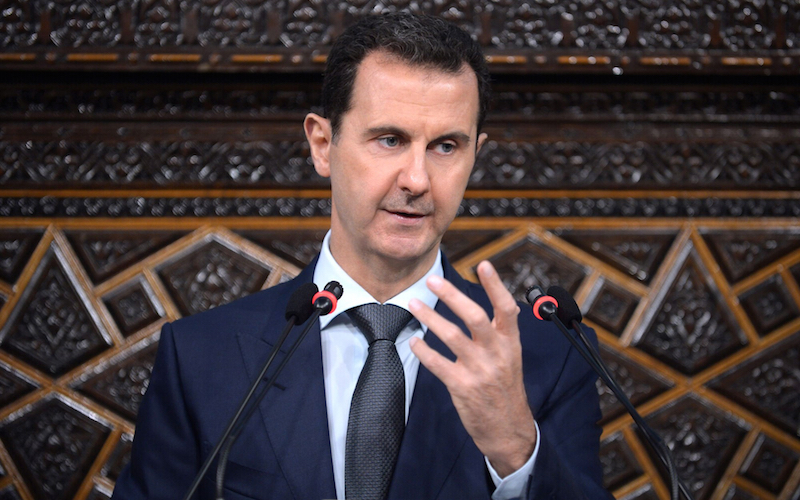
Syria: Chemical Weapons are the New Norm
On August 2nd in Syria’s Idlib province, a Russian Mi-8 helicopter was shot down by anti-regime rebels associated with Jaish al-Fatah, killing five Russian soldiers in the largest single reported loss of life among Russian forces in that conflict. Video footage taken at the site showed the body of the Russian pilot being dragged through the streets.
Shortly thereafter, in what local activists labeled a revenge attack, a helicopter affiliated with the Assad regime reportedly dropped two canisters of chlorine gas on the city of Saraqib in northwestern Syria, affecting 33 civilians who were treated for chlorine inhalation, including 18 women and children. On the same day, in a second attack in Aleppo, the Syrian regime claimed that eight civilians were injured and five killed when rebel forces also supposedly employed chemical weapons. While the Organization for the Prohibition of Chemical Weapons, the international body responsible for monitoring use of chemical weapons under the Chemical Weapons Convention, has not officially declared that chemical weapons were employed in either attack, the nature of survivors’ injuries in Saraqib strongly suggested the presence of chlorine gas; videos posted to YouTube showed survivors struggling to breathe and receiving oxygen masks by rescue workers.
Although international speculation has concentrated on whether the event in Saraqib was indeed a revenge attack, this focus misses an important point: these two attacks highlight a disturbing trend towards the normalization of chemical weapons use in the Syrian conflict, and by regional actors generally, especially ISIS. Chemical weapons are far from new in the Syrian conflict. Various reports have ascribed their use to the regime, rebel forces, ISIS, and Russian forces as well.
In the largest attack, in August of 2013, unguided surface-to-surface rockets containing sarin gas of the type commonly employed by government forces landed in Ghouta, Syria, affecting up to several thousand residents. The regime has strenuously denied using chemical weapons in this attack, and places the blame squarely on rebel forces in the area, both CIA and NSA assert with “high confidence” that the regime was responsible for the attack.
At the time, the UN judged this to be the largest use of chemical weapons against civilians since Saddam Hussein attacked the Iraqi Kurds with chemical agents in 1988. The attack also represented a substantial violation of Obama’s infamous “red line” in Syria that would supposedly force Washington to respond. The Syrian American Medical Society has documented 161 chemical attacks since the beginning of the Syrian conflict, leading to at least 1,491 deaths and 14,581 injuries from exposure as of March 2016; these figures are in addition to another 133 unsubstantiated chemical attacks.
The UN Security Council Resolution 2118, passed in September of 2013, mandated the destruction of the Syrian regime’s chemical weapons, and triumphantly, the Organisation for the Prohibition of Chemical Weapons had announced the destruction of 75 canisters of hydrogen fluoride (a critical component in the manufacture of sarin gas), eliminating the regime’s stockpile in January 2016. However, because chlorine is used to purify drinking water, it is easily available (although it must be weaponized) and not explicitly banned under the Chemical Weapons Convention.
With the development of its own chemical weapons unit, ISIS’ capacity to deploy such weapons has been of increasing concern to the U.S. and NATO. While U.S. Special Forces announced the capture of the leader of this unit in March 2016, CIA Director John Brennan has confirmed that ISIS retains the capability to produce both chlorine and mustard gas, making it the first terrorist group to do so since the Aum Shunrikiyo group in Japan in the 1990s. ISIS appears to be making use of this capability; in April 2016, Kurdish forces in Northern Iraq complained of nausea and vomiting after an ISIS mortar attack, indicating the use of mustard gas.
In fact, while many international observers agree that the vast majority of chemical weapons attacks in Syria so far have been initiated by the Assad regime, the use of chemical weapons is generally becoming more widespread in the Syrian conflict by multiple actors, as both ISIS and rebel forces have been accused of deploying various chemical agents in the past year. Besides the Kurdish attack, ISIS is also suspected of using mustard gas in an attack on the Deir Ezzor military base in Syria in April 2016, and in an attack on Taza city near Kirkuk, Iraq, that affected more than 1,500 in March 2016. (On August 8th, Russia claimed to have used airstrikes to destroy a chemical weapons factory used by ISIS in Raqqa, Syria.) In November 2015, Russian forces were also accused of using white phosphorus against civilians in an attack on Raqqa, and the Assad regime has also accused other rebel groups of using mustard gas in the town of Marea, north of Aleppo, in November 2015.
If these recent attacks are considered as a whole, the picture that emerges is one in which multiple groups, including various rebel factions (some of which are supported by the U.S.), ISIS and groups aligned with ISIS, and the Assad regime all seem to be utilizing chemical weapons in attacks involving civilians, with multiple attacks taking place outside of Syria. And, these attacks have flown in the face of UN conventions, UNSC resolutions, and the best enforcement efforts of the OPCW not in a remote and unknown conflict, but all while Syria remains under intense scrutiny by the international community. Additionally concerning is the fact that the delivery systems used to deliver chemical weapons – barrel bombs and unguided missiles – do not feature precision targeting systems, but are haphazardly aimed, increasing the chance of civilian casualties. While the imposition of a no-fly zone remains highly contentious among NATO forces and Russia, it might be able to eliminate the use of barrel bombs through aerial attacks. But this would hardly represent a comprehensive solution because other delivery systems, such as surface-to-surface rockets and mortars, would still remain.
The CWC is hardly the first UN convention to receive inadequate and inconsistent enforcement, but the scope and potential brutality of chemical weapons attacks is such that this convention in particular requires sustained attention by the international community. It is possible that the Syrian civil war reflects a slow-motion reorientation towards chemical weapons, in which their sporadic use, sustained over the long term, normalizes their use in future conflicts by exposing an absence of ultimate consequences.

